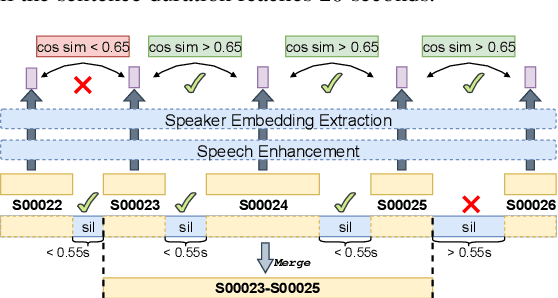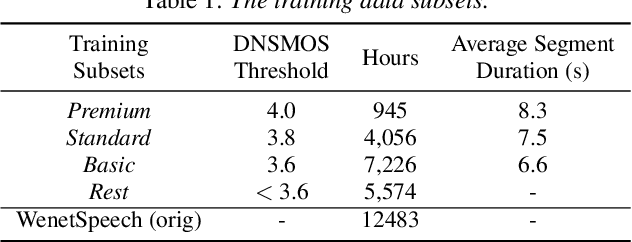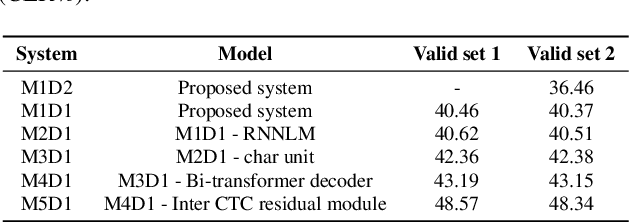Binbin Zhang
Adapting Whisper for Streaming Speech Recognition via Two-Pass Decoding
Jun 13, 2025Abstract:OpenAI Whisper is a family of robust Automatic Speech Recognition (ASR) models trained on 680,000 hours of audio. However, its encoder-decoder architecture, trained with a sequence-to-sequence objective, lacks native support for streaming ASR. In this paper, we fine-tune Whisper for streaming ASR using the WeNet toolkit by adopting a Unified Two-pass (U2) structure. We introduce an additional Connectionist Temporal Classification (CTC) decoder trained with causal attention masks to generate streaming partial transcripts, while the original Whisper decoder reranks these partial outputs. Our experiments on LibriSpeech and an earnings call dataset demonstrate that, with adequate fine-tuning data, Whisper can be adapted into a capable streaming ASR model. We also introduce a hybrid tokenizer approach, which uses a smaller token space for the CTC decoder while retaining Whisper's original token space for the attention decoder, resulting in improved data efficiency and generalization.
TouchASP: Elastic Automatic Speech Perception that Everyone Can Touch
Dec 20, 2024



Abstract:Large Automatic Speech Recognition (ASR) models demand a vast number of parameters, copious amounts of data, and significant computational resources during the training process. However, such models can merely be deployed on high-compute cloud platforms and are only capable of performing speech recognition tasks. This leads to high costs and restricted capabilities. In this report, we initially propose the elastic mixture of the expert (eMoE) model. This model can be trained just once and then be elastically scaled in accordance with deployment requirements. Secondly, we devise an unsupervised data creation and validation procedure and gather millions of hours of audio data from diverse domains for training. Using these two techniques, our system achieves elastic deployment capabilities while reducing the Character Error Rate (CER) on the SpeechIO testsets from 4.98\% to 2.45\%. Thirdly, our model is not only competent in Mandarin speech recognition but also proficient in multilingual, multi-dialect, emotion, gender, and sound event perception. We refer to this as Automatic Speech Perception (ASP), and the perception results are presented in the experimental section.
TouchTTS: An Embarrassingly Simple TTS Framework that Everyone Can Touch
Dec 12, 2024Abstract:It is well known that LLM-based systems are data-hungry. Recent LLM-based TTS works typically employ complex data processing pipelines to obtain high-quality training data. These sophisticated pipelines require excellent models at each stage (e.g., speech denoising, speech enhancement, speaker diarization, and punctuation models), which themselves demand high-quality training data and are rarely open-sourced. Even with state-of-the-art models, issues persist, such as incomplete background noise removal and misalignment between punctuation and actual speech pauses. Moreover, the stringent filtering strategies often retain only 10-30\% of the original data, significantly impeding data scaling efforts. In this work, we leverage a noise-robust audio tokenizer (S3Tokenizer) to design a simplified yet effective TTS data processing pipeline that maintains data quality while substantially reducing data acquisition costs, achieving a data retention rate of over 50\%. Beyond data scaling challenges, LLM-based TTS systems also incur higher deployment costs compared to conventional approaches. Current systems typically use LLMs solely for text-to-token generation, while requiring separate models (e.g., flow matching models) for token-to-waveform generation, which cannot be directly executed by LLM inference engines, further complicating deployment. To address these challenges, we eliminate redundant modules in both LLM and flow components, replacing the flow model backbone with an LLM architecture. Building upon this simplified flow backbone, we propose a unified architecture for both streaming and non-streaming inference, significantly reducing deployment costs. Finally, we explore the feasibility of unifying TTS and ASR tasks using the same data for training, thanks to the simplified pipeline and the S3Tokenizer that reduces the quality requirements for TTS training data.
Findings of the 2024 Mandarin Stuttering Event Detection and Automatic Speech Recognition Challenge
Sep 09, 2024



Abstract:The StutteringSpeech Challenge focuses on advancing speech technologies for people who stutter, specifically targeting Stuttering Event Detection (SED) and Automatic Speech Recognition (ASR) in Mandarin. The challenge comprises three tracks: (1) SED, which aims to develop systems for detection of stuttering events; (2) ASR, which focuses on creating robust systems for recognizing stuttered speech; and (3) Research track for innovative approaches utilizing the provided dataset. We utilizes an open-source Mandarin stuttering dataset AS-70, which has been split into new training and test sets for the challenge. This paper presents the dataset, details the challenge tracks, and analyzes the performance of the top systems, highlighting improvements in detection accuracy and reductions in recognition error rates. Our findings underscore the potential of specialized models and augmentation strategies in developing stuttered speech technologies.
HydraFormer: One Encoder For All Subsampling Rates
Aug 08, 2024



Abstract:In automatic speech recognition, subsampling is essential for tackling diverse scenarios. However, the inadequacy of a single subsampling rate to address various real-world situations often necessitates training and deploying multiple models, consequently increasing associated costs. To address this issue, we propose HydraFormer, comprising HydraSub, a Conformer-based encoder, and a BiTransformer-based decoder. HydraSub encompasses multiple branches, each representing a distinct subsampling rate, allowing for the flexible selection of any branch during inference based on the specific use case. HydraFormer can efficiently manage different subsampling rates, significantly reducing training and deployment expenses. Experiments on AISHELL-1 and LibriSpeech datasets reveal that HydraFormer effectively adapts to various subsampling rates and languages while maintaining high recognition performance. Additionally, HydraFormer showcases exceptional stability, sustaining consistent performance under various initialization conditions, and exhibits robust transferability by learning from pretrained single subsampling rate automatic speech recognition models\footnote{Model code and scripts: https://github.com/HydraFormer/hydraformer}.
WenetSpeech4TTS: A 12,800-hour Mandarin TTS Corpus for Large Speech Generation Model Benchmark
Jun 11, 2024



Abstract:With the development of large text-to-speech (TTS) models and scale-up of the training data, state-of-the-art TTS systems have achieved impressive performance. In this paper, we present WenetSpeech4TTS, a multi-domain Mandarin corpus derived from the open-sourced WenetSpeech dataset. Tailored for the text-to-speech tasks, we refined WenetSpeech by adjusting segment boundaries, enhancing the audio quality, and eliminating speaker mixing within each segment. Following a more accurate transcription process and quality-based data filtering process, the obtained WenetSpeech4TTS corpus contains $12,800$ hours of paired audio-text data. Furthermore, we have created subsets of varying sizes, categorized by segment quality scores to allow for TTS model training and fine-tuning. VALL-E and NaturalSpeech 2 systems are trained and fine-tuned on these subsets to validate the usability of WenetSpeech4TTS, establishing baselines on benchmark for fair comparison of TTS systems. The corpus and corresponding benchmarks are publicly available on huggingface.
AS-70: A Mandarin stuttered speech dataset for automatic speech recognition and stuttering event detection
Jun 11, 2024


Abstract:The rapid advancements in speech technologies over the past two decades have led to human-level performance in tasks like automatic speech recognition (ASR) for fluent speech. However, the efficacy of these models diminishes when applied to atypical speech, such as stuttering. This paper introduces AS-70, the first publicly available Mandarin stuttered speech dataset, which stands out as the largest dataset in its category. Encompassing conversational and voice command reading speech, AS-70 includes verbatim manual transcription, rendering it suitable for various speech-related tasks. Furthermore, baseline systems are established, and experimental results are presented for ASR and stuttering event detection (SED) tasks. By incorporating this dataset into the model fine-tuning, significant improvements in the state-of-the-art ASR models, e.g., Whisper and Hubert, are observed, enhancing their inclusivity in addressing stuttered speech.
U2++ MoE: Scaling 4.7x parameters with minimal impact on RTF
Apr 25, 2024



Abstract:Scale has opened new frontiers in natural language processing, but at a high cost. In response, by learning to only activate a subset of parameters in training and inference, Mixture-of-Experts (MoE) have been proposed as an energy efficient path to even larger and more capable language models and this shift towards a new generation of foundation models is gaining momentum, particularly within the field of Automatic Speech Recognition (ASR). Recent works that incorporating MoE into ASR models have complex designs such as routing frames via supplementary embedding network, improving multilingual ability for the experts, and utilizing dedicated auxiliary losses for either expert load balancing or specific language handling. We found that delicate designs are not necessary, while an embarrassingly simple substitution of MoE layers for all Feed-Forward Network (FFN) layers is competent for the ASR task. To be more specific, we benchmark our proposed model on a large scale inner-source dataset (160k hours), the results show that we can scale our baseline Conformer (Dense-225M) to its MoE counterparts (MoE-1B) and achieve Dense-1B level Word Error Rate (WER) while maintaining a Dense-225M level Real Time Factor (RTF). Furthermore, by applying Unified 2-pass framework with bidirectional attention decoders (U2++), we achieve the streaming and non-streaming decoding modes in a single MoE based model, which we call U2++ MoE. We hope that our study can facilitate the research on scaling speech foundation models without sacrificing deployment efficiency.
ICMC-ASR: The ICASSP 2024 In-Car Multi-Channel Automatic Speech Recognition Challenge
Jan 07, 2024

Abstract:To promote speech processing and recognition research in driving scenarios, we build on the success of the Intelligent Cockpit Speech Recognition Challenge (ICSRC) held at ISCSLP 2022 and launch the ICASSP 2024 In-Car Multi-Channel Automatic Speech Recognition (ICMC-ASR) Challenge. This challenge collects over 100 hours of multi-channel speech data recorded inside a new energy vehicle and 40 hours of noise for data augmentation. Two tracks, including automatic speech recognition (ASR) and automatic speech diarization and recognition (ASDR) are set up, using character error rate (CER) and concatenated minimum permutation character error rate (cpCER) as evaluation metrics, respectively. Overall, the ICMC-ASR Challenge attracts 98 participating teams and receives 53 valid results in both tracks. In the end, first-place team USTCiflytek achieves a CER of 13.16% in the ASR track and a cpCER of 21.48% in the ASDR track, showing an absolute improvement of 13.08% and 51.4% compared to our challenge baseline, respectively.
The GUA-Speech System Description for CNVSRC Challenge 2023
Dec 12, 2023


Abstract:This study describes our system for Task 1 Single-speaker Visual Speech Recognition (VSR) fixed track in the Chinese Continuous Visual Speech Recognition Challenge (CNVSRC) 2023. Specifically, we use intermediate connectionist temporal classification (Inter CTC) residual modules to relax the conditional independence assumption of CTC in our model. Then we use a bi-transformer decoder to enable the model to capture both past and future contextual information. In addition, we use Chinese characters as the modeling units to improve the recognition accuracy of our model. Finally, we use a recurrent neural network language model (RNNLM) for shallow fusion in the inference stage. Experiments show that our system achieves a character error rate (CER) of 38.09% on the Eval set which reaches a relative CER reduction of 21.63% over the official baseline, and obtains a second place in the challenge.
 Add to Chrome
Add to Chrome Add to Firefox
Add to Firefox Add to Edge
Add to Edge